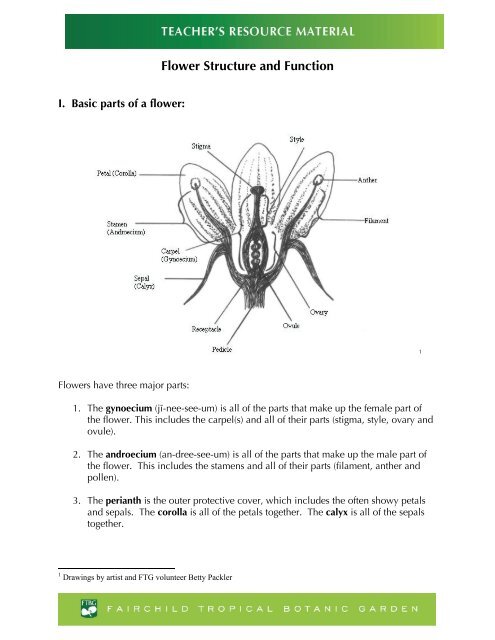Flower Structure and Function
Create successful ePaper yourself
Turn your PDF publications into a flip-book with our unique Google optimized e-Paper software.
<strong>Flower</strong> <strong>Structure</strong> <strong>and</strong> <strong>Function</strong><br />
I. Basic parts of a flower:<br />
1<br />
<strong>Flower</strong>s have three major parts:<br />
1. The gynoecium (jī-nee-see-um) is all of the parts that make up the female part of<br />
the flower. This includes the carpel(s) <strong>and</strong> all of their parts (stigma, style, ovary <strong>and</strong><br />
ovule).<br />
2. The <strong>and</strong>roecium (an-dree-see-um) is all of the parts that make up the male part of<br />
the flower. This includes the stamens <strong>and</strong> all of their parts (filament, anther <strong>and</strong><br />
pollen).<br />
3. The perianth is the outer protective cover, which includes the often showy petals<br />
<strong>and</strong> sepals. The corolla is all of the petals together. The calyx is all of the sepals<br />
together.<br />
1 Drawings by artist <strong>and</strong> FTG volunteer Betty Packler
II. Males <strong>and</strong> Females:<br />
Some flowers have only a gynoecium (pl. gynoecia), meaning they are “female” flowers.<br />
We call these carpellate (sometimes called pistillate) flowers. Carpellate flowers produce<br />
fruit.<br />
Some flowers have only <strong>and</strong>roecium (pl. <strong>and</strong>roecia), meaning they are “male” flowers.<br />
We call these staminate flowers. Staminate flowers produce only pollen <strong>and</strong> are not<br />
capable of producing fruit.<br />
<strong>Flower</strong>s that have both male <strong>and</strong> female parts, like the one in the diagram on the first<br />
page, are called perfect flowers. Perfect flowers produce fruit. Most plants have perfect<br />
flowers.<br />
Plants that do not have perfect flowers, but have separate carpellate <strong>and</strong> staminate flowers<br />
are divided into two categories:<br />
<br />
Plants that have carpellate <strong>and</strong> staminate flowers on a single individual are called<br />
monoecious (mō–nee–shus).<br />
<br />
Plants that have carpellate <strong>and</strong> staminate flowers on separate individual plants are<br />
called dioecious (dī-ee-shus). In these plants, only the individuals with carpellate<br />
flowers will produce fruit. The staminate individuals, lacking ovaries, never will.
III. Floral <strong>Function</strong><br />
The basic function of a flower is reproduction. A flower is pollinated when pollen from an<br />
anther is delivered to a stigma. The pollen germinates on the stigma <strong>and</strong> forms a pollen<br />
tube that delivers sperm to the egg within the ovule.<br />
The fertilized egg develops into an embryo. The polar nuclei are also fertilized <strong>and</strong><br />
develop into endosperm, which is nutritive tissue for the embryo. The seed is the embryo<br />
plus the endosperm.
<strong>Flower</strong>ing plants package their seeds into fruits. A fruit develops from an ovary when the<br />
ovules have been fertilized by pollen. The fruit can function to protect the seeds <strong>and</strong>,<br />
sometimes, to attract animals who will eat the fruit <strong>and</strong> disperse the seeds to another<br />
location.


